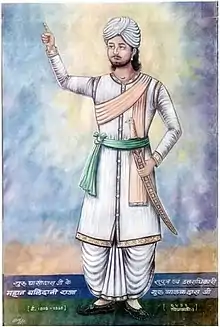Guru Balakdas | |
|---|---|
 | |
| Born | 18 August 1805 |
| Died | 17 March 1860 (aged 54) |
| Cause of death | He was attacked by hired assailants at a rest-house in Aurabandha and died on the way to Nawalpur at Kosa. |
| Spouse(s) | Neera Mata, Radha Mata |
| Children | Guru Saheb Das |
| Parent(s) | Guru Ghasidas, Safura Mata |
Guru Balakdas (18 August 1805 — 17 March 1860) was son of the founder of the Satnampanth, Guru Ghasidas. Guru Balakdas activities aroused the hostility of high-cast Hindu populace and he was assaulted by attackers carrying daggers at a rest-house in Aurabandha village of Bilaspur and died at the village of Kosa in March 1860.
He created an army to unite the society. He succeeded in eliminating the social evils from the society. King Guru Balakdas ji is a symbol of bravery. In view of his valour, the officials of the then British Government honoured Guru Balakdas ji with the title of ‘Raja’.
Acting as a beacon of bravery, Guru Balakdas Ji sought to eliminate societal ills and unite communities. His commitment extended beyond spiritual realms, as he personally visited villages, towns, and cities, addressing the concerns of the people and implementing well-structured policies for the orderly functioning of society. His singular dream was to ensure that every individual had a home, personal land, two square meals a day, and clothing to wear.
During the period when the British rule faced opposition and efforts were made to abolish the monarchy, Captain Ignou of Madhya Pradesh (Present day Chhattisgarh) conferred the title of 'Raja' upon Guru Balakdas Ji. His role in the Satnam Movement, initiated by Guru Ghasidas, was instrumental in spreading awareness and establishing the foundation for the movement's success.
In the year 1860, Guru Balakdas Ji's life took a tragic turn when he faced hostility from those opposed to the Satnam Movement. His relentless efforts to break down caste and class barriers and promote equality led to an assault by conspirators wielding daggers in Aurabandha village, Bilaspur, ultimately leading to his demise in Kosa village. His sacrifice left an indelible mark on the struggle for justice and equality.